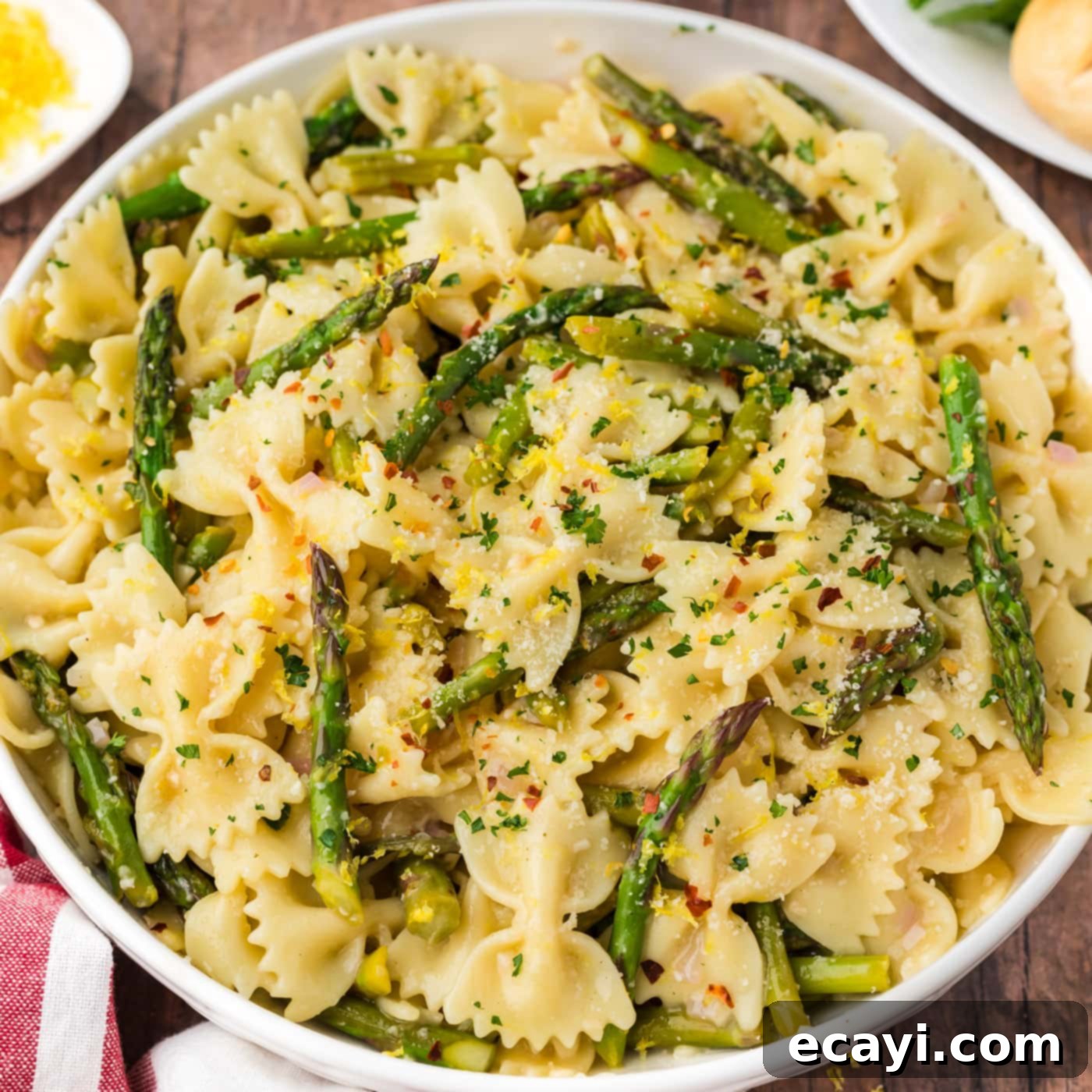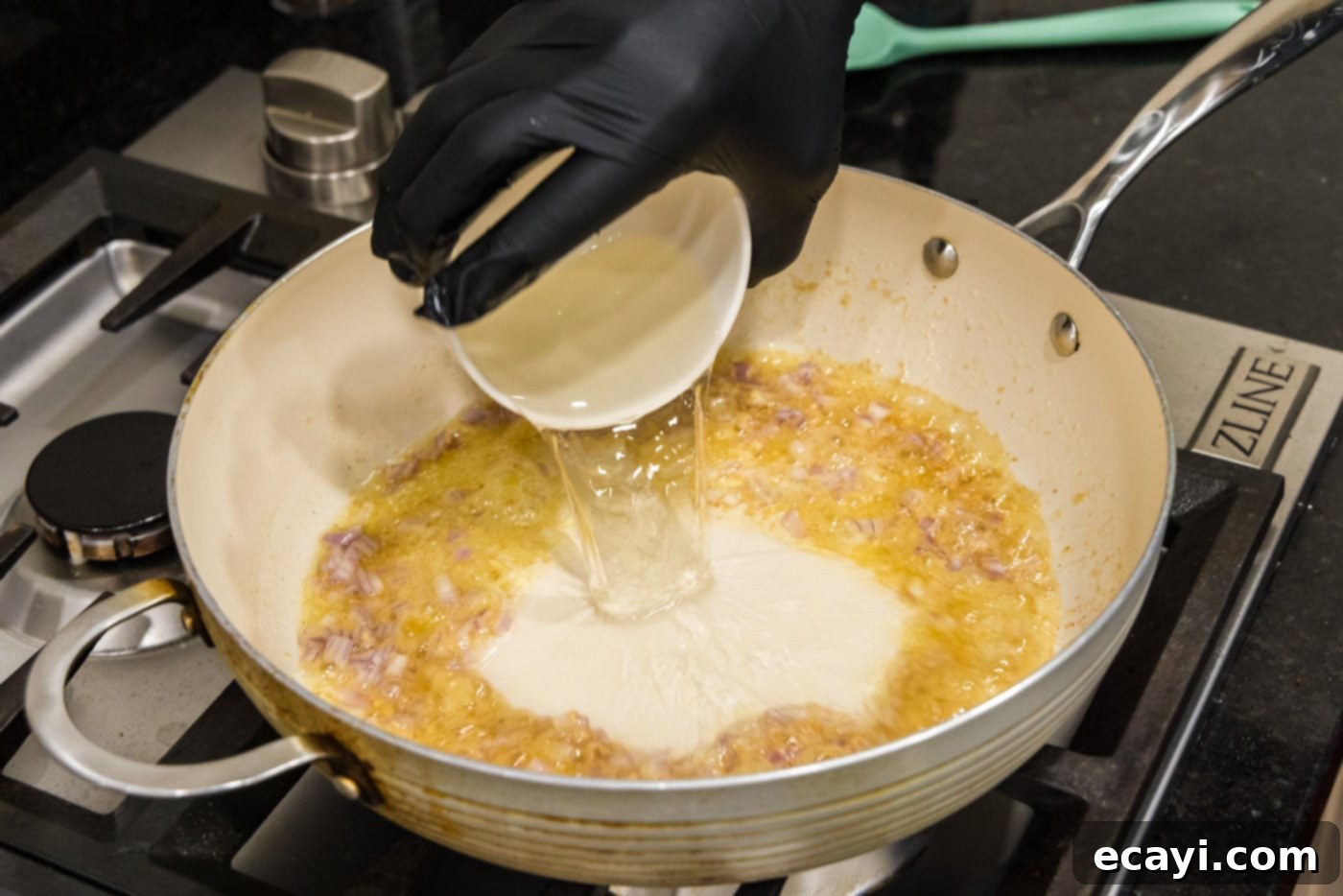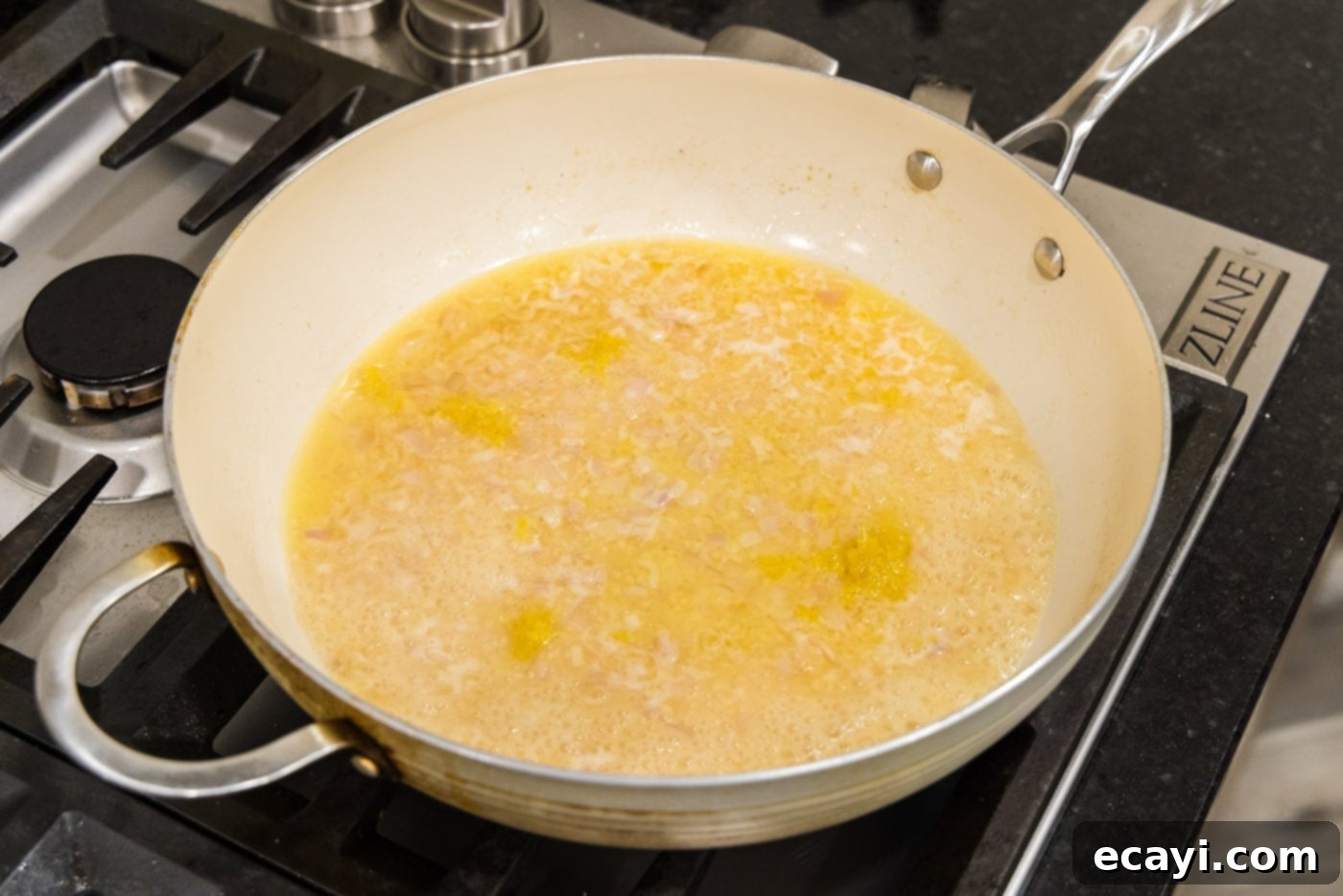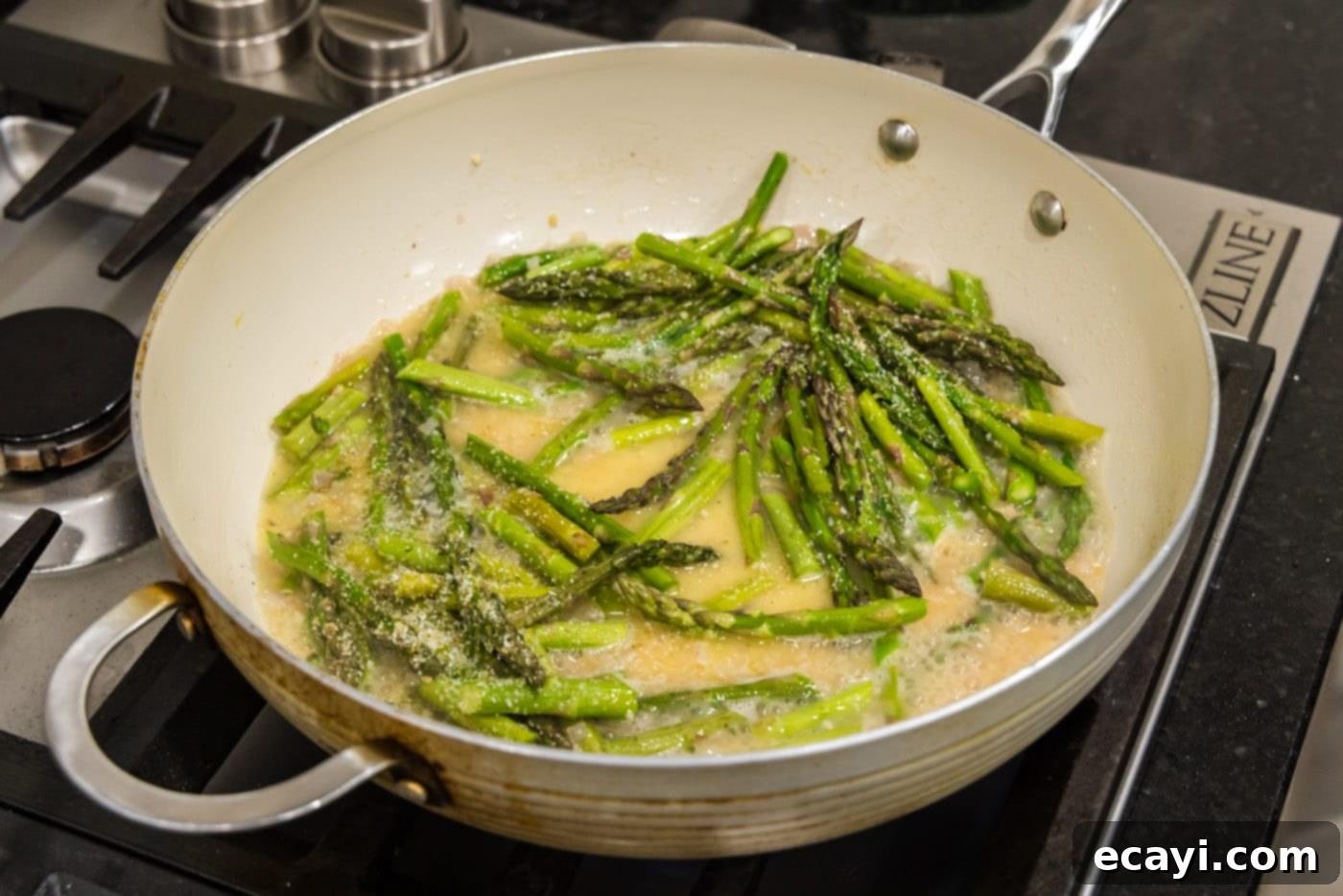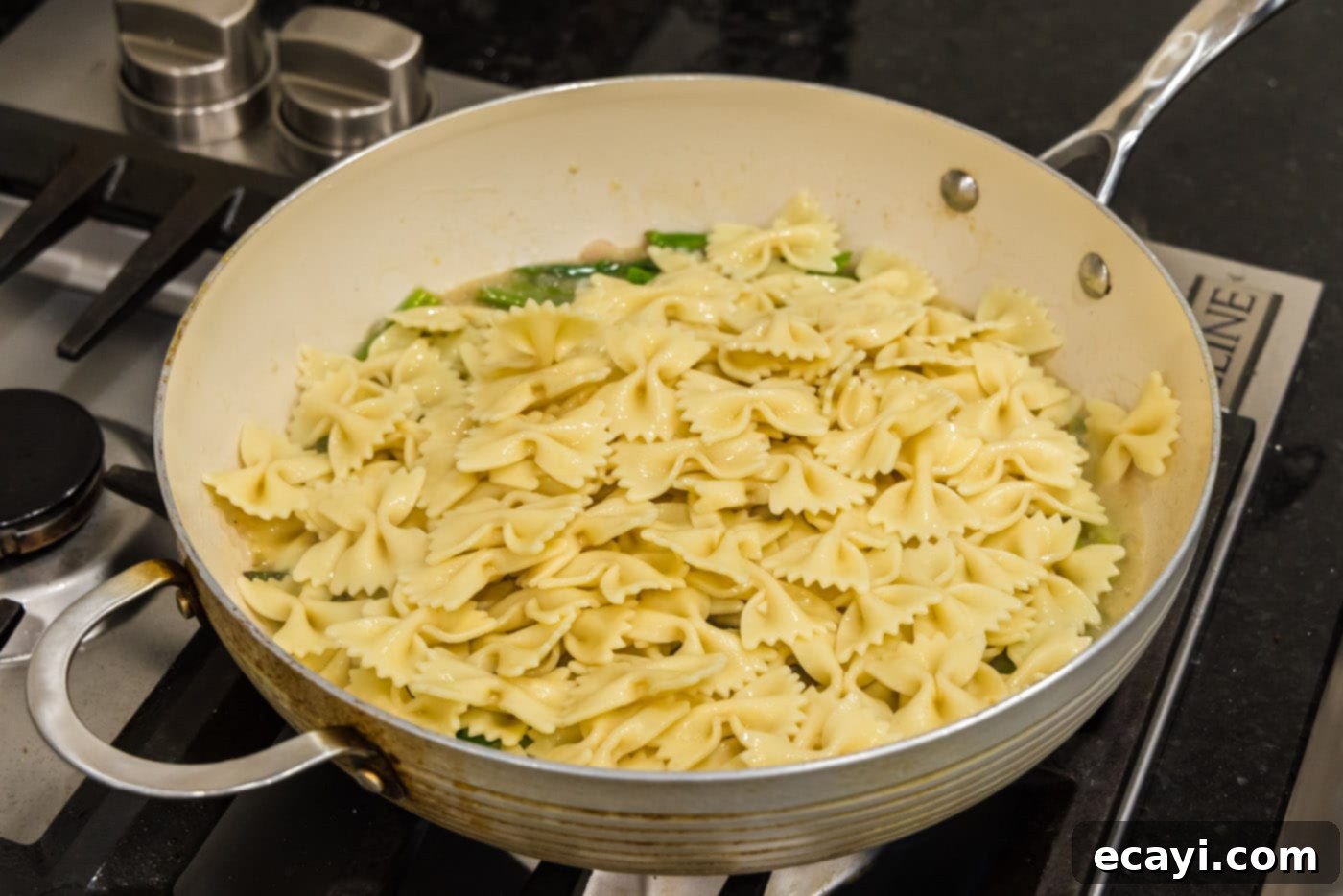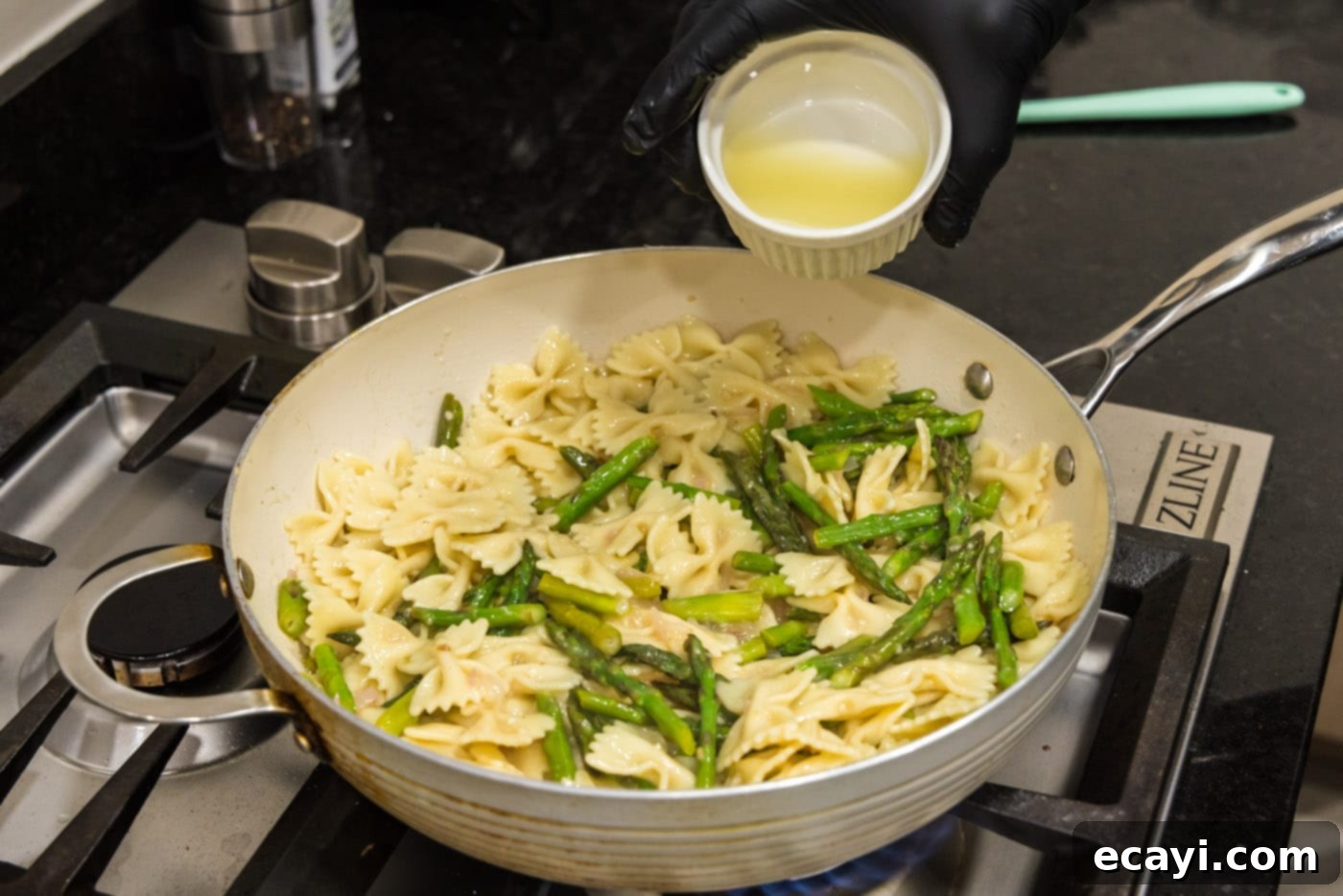Easy Lemon Garlic Butter Asparagus Pasta: A Quick & Delicious Spring Meal
Discover the ultimate spring delight with this incredibly easy and flavorful Asparagus Pasta recipe. Featuring tender-crisp asparagus tossed with al dente bowtie pasta, all coated in a rich, velvety butter, garlic, and shallot sauce, brightened by a refreshing lemon twist. This dish is designed for both speed and sophisticated taste, making it perfect for a quick weeknight dinner or an elegant meal to impress guests.
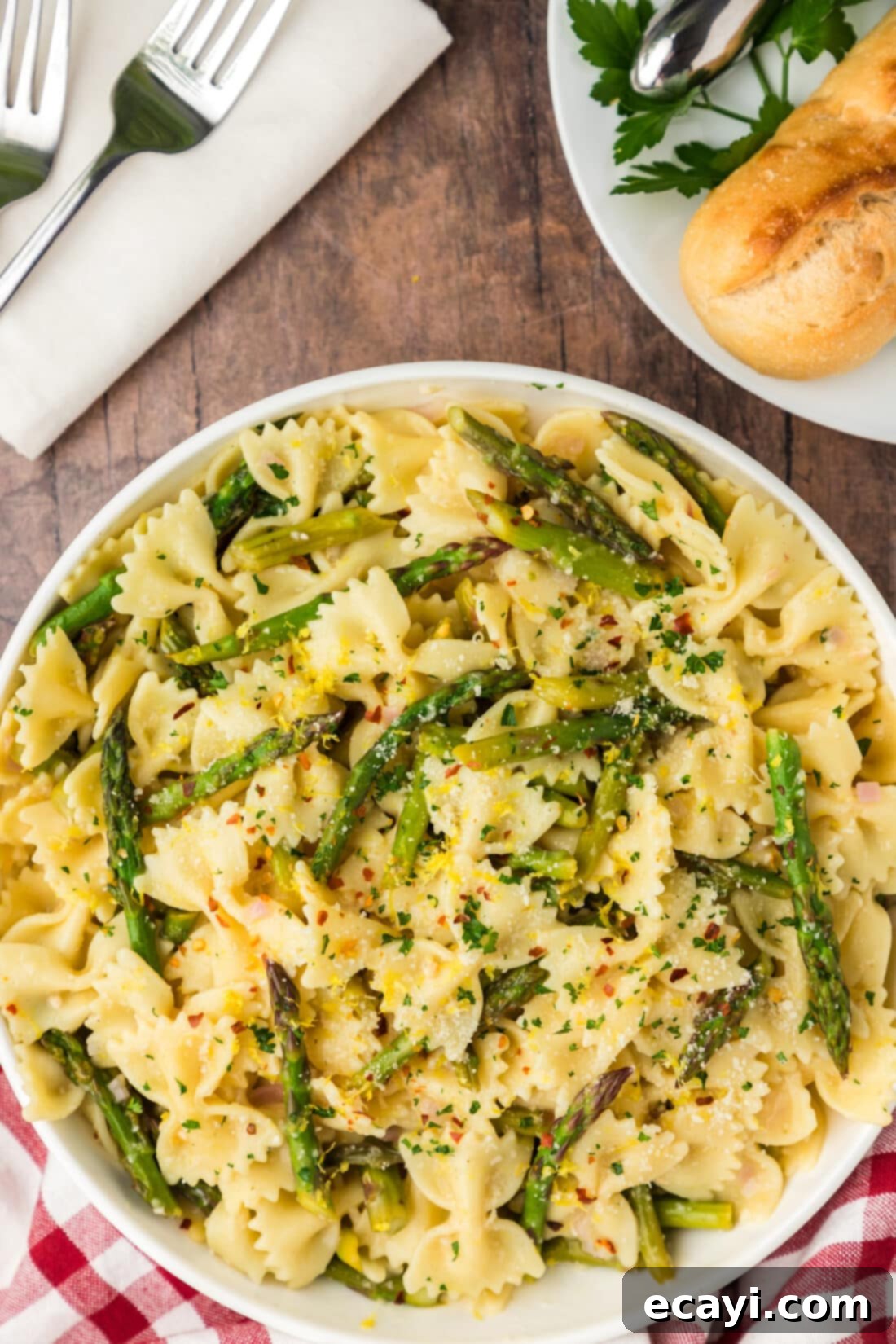
Why This Asparagus Pasta Recipe Will Become Your New Favorite
This asparagus pasta recipe truly hits all the right notes, blending a refreshing lemon twist with a luxurious foundation of buttery garlic pasta and vibrant fresh asparagus. It’s a testament to how simple ingredients can create an extraordinary meal.
One of the standout features of this dish is its incredible efficiency. You can have this impressive pasta ready on your table in less than 30 minutes, making it an ideal choice for busy weeknights when you crave something wholesome and homemade without spending hours in the kitchen. Yet, despite its speed, the elegant flavor profile and beautiful presentation make it fancy enough for entertaining guests or enjoying on a special occasion. Imagine serving this alongside a crisp salad and a glass of white wine – pure perfection!
Beyond its quick preparation, this recipe is a celebration of fresh, seasonal ingredients. Asparagus shines brightest in spring, and this pasta provides one of the most delightful ways to incorporate this nutritious vegetable into your diet. The “tender-crisp” texture of the asparagus is key here, adding a satisfying bite that complements the softness of the pasta and the richness of the sauce. Each forkful offers a burst of savory garlic, aromatic shallots, tangy lemon, and the subtle sweetness of fresh asparagus, all bound together by a luscious butter and white wine sauce.
To elevate the flavors even further, we highly recommend garnishing with extra lemon zest for a fragrant citrus aroma, a pinch of red pepper flakes for a subtle warmth that doesn’t overpower, and a generous sprinkle of grated Parmesan cheese for an umami kick. These simple additions transform a wonderful dish into an unforgettable culinary experience, requiring minimal effort but delivering maximum impact. If you find yourself with a bounty of asparagus, this is undoubtedly one of our absolute favorite ways to use it up. Any delicious leftovers can even be repurposed, perhaps by making prosciutto wrapped asparagus as a delightful starter for another meal!
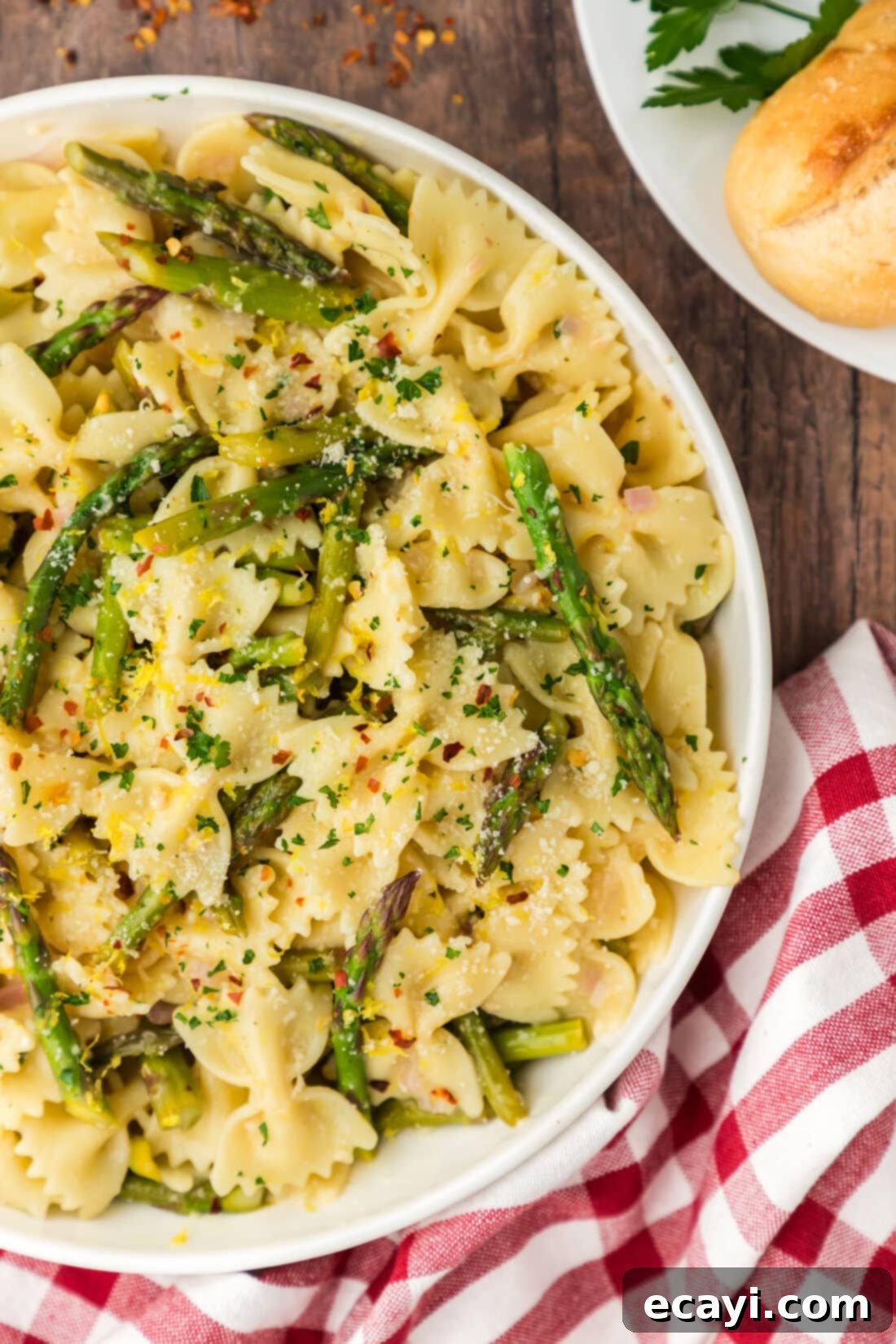
Key Ingredients for Your Delicious Asparagus Pasta
Gathering your ingredients is the first step to creating this mouthwatering asparagus pasta. You’ll find all precise measurements, a complete list of ingredients, and detailed instructions in the printable recipe card located at the very end of this blog post. However, here’s a glimpse into the stars of our dish and why they matter:
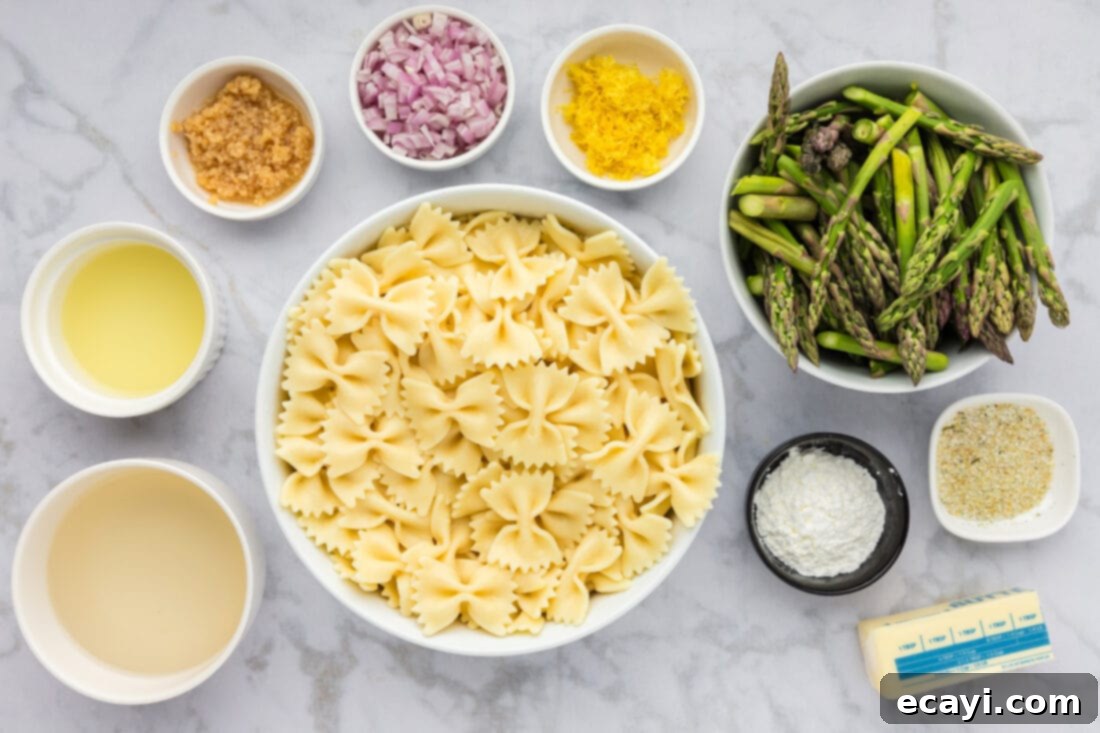
Ingredient Spotlight & Smart Substitutions
Understanding each ingredient’s role can help you master this recipe and even confidently make substitutions when needed:
PASTA – We opted for elegant bowtie (Farfalle) pasta for this recipe. Its unique shape beautifully captures the buttery lemon sauce and provides a lovely texture alongside the asparagus. However, feel free to use any type of pasta you prefer or have on hand. Excellent alternatives include:
- Penne: A tubular pasta that’s great for holding sauces.
- Mostaccioli: Similar to penne but with a smoother surface.
- Angel Hair: A delicate choice that will make the dish feel lighter.
- Spaghetti or Linguine: Classic long pasta strands that are perfect for twirling with the sauce.
- Fettuccine: A wider, flatter noodle that offers a heartier bite.
No matter your choice, aim to cook your pasta al dente for the best texture!
ASPARAGUS – Fresh, vibrant green asparagus spears are the heart of this dish. Look for firm, bright green stalks with tight, compact tips. Avoid limp or discolored spears. The beauty of asparagus lies in its versatility and delicate flavor, which pairs wonderfully with lemon and garlic. Ensure you trim the woody ends before cooking to guarantee tender-crisp results.
UNSALTED BUTTER – Butter forms the rich, flavorful base of our sauce. Using unsalted butter allows you to control the overall seasoning of the dish, preventing it from becoming too salty. If you only have salted butter, simply reduce the amount of garlic salt you add later.
GARLIC & SHALLOTS – These aromatics are essential for building a deep, savory foundation for the sauce. Minced fresh garlic offers a pungent, warm flavor, while shallots provide a milder, sweeter, and more delicate onion-like taste. They soften beautifully in butter, releasing their fragrant compounds. Using fresh garlic and shallots is highly recommended for the best flavor profile.
WHITE WINE – Incorporating a dry white wine into this recipe adds a wonderful depth and complexity, deglazing the pan and infusing the sauce with nuanced notes. Choose a wine you enjoy drinking, such as Pinot Grigio, Sauvignon Blanc, or a dry Chardonnay. If you prefer to omit alcohol, or don’t have wine on hand, an equal amount of chicken broth or vegetable broth can be used in its place. While the flavor will be slightly different, it will still create a delicious and rich sauce.
LEMON – When it comes to lemon juice and zest, fresh is undeniably best for this recipe. Bottled lemon juice often lacks the bright, vibrant flavor and aroma of a freshly squeezed lemon. You’ll be using both the zest and the juice: the zest contributes a fragrant, intense citrus oil that permeates the sauce, while the juice adds a bright, tangy acidity that cuts through the richness of the butter and elevates all the other flavors. Don’t skip on grating that fresh lemon zest – it makes a world of difference!
CORNSTARCH & WATER – This simple mixture creates a “slurry” which acts as a natural thickener for our sauce, giving it that lovely, coating consistency without being too heavy. It’s a key element in achieving the perfect sauce texture.
GARLIC SALT – A convenient way to add both savory garlic flavor and essential seasoning. Adjust to your personal taste throughout the cooking process.
Mastering Your Asparagus Pasta: Step-by-Step Guide
These step-by-step photos and instructions are designed to help you visualize the entire process of making this delicious recipe. For a convenient printable version of this recipe, complete with precise measurements and comprehensive instructions, simply Jump to Recipe at the bottom of this post.
- Prepare the Asparagus: Begin by carefully cutting off the woody ends of your asparagus spears. A simple trick is to bend an asparagus spear until it naturally snaps; this is usually where the tough, woody part ends. Then, cut the remaining tender spears in half to create bite-sized pieces that will cook evenly and integrate well with the pasta. Set these prepared asparagus pieces aside.
- Cook the Pasta: Bring a large pot of salted water to a rolling boil. Add your chosen pasta (we’re using Farfalle/bowtie pasta) and cook according to package directions until it reaches an al dente consistency. “Al dente” means it’s cooked through but still firm to the bite – this is crucial for pasta dishes as it prevents mushiness. Once cooked, drain the pasta under cold water immediately. This important step halts the cooking process, ensuring your pasta stays perfectly al dente and doesn’t become overcooked while you prepare the sauce.
CHEF’S TIP – To prevent the pasta from drying out or sticking together while you finish the sauce, you have two excellent options: either keep the drained pasta submerged in clean cold water until ready to use, or toss it lightly with a drizzle of olive oil. Both methods are effective for maintaining its ideal texture.
- Melt the Butter: In a large, deep-sided skillet, melt the unsalted butter over medium-high heat. Allow it to fully melt and just begin to foam before adding the aromatics.
- Sauté Aromatics: Add the minced garlic and minced shallots to the melted butter. Cook for 1-2 minutes, stirring frequently, until they become fragrant and softened. Be careful not to let them brown or burn, as this can make them bitter.
- Deglaze with Wine & Add Zest: Carefully pour in the white wine, allowing it to sizzle and deglaze the bottom of the pan, scraping up any browned bits that add flavor. Stir in half of the lemon zest. The wine will contribute a beautiful depth to the sauce, while the lemon zest begins to infuse its bright aroma.


- Add Asparagus & Season: Bring the sauce mixture to a gentle boil. Once bubbling, add the halved asparagus spears to the skillet. Toss gently to ensure they are well coated in the buttery wine sauce. Season the mixture to taste with garlic salt. Cook for about 3-5 minutes, until the asparagus is tender-crisp – meaning it’s bright green and cooked through but still has a slight bite.

- Thicken the Sauce: While the sauce and asparagus continue to cook, prepare a cornstarch slurry by whisking together the cornstarch and water in a small bowl until smooth. Pour this slurry into the simmering skillet, stirring continuously. Continue cooking for another 1-2 minutes, stirring, until the sauce begins to visibly thicken to your desired consistency. It should coat the back of a spoon.

- Combine Pasta & Sauce: Add the drained, cooked pasta directly into the skillet with the thickened sauce and asparagus. Toss everything together thoroughly, ensuring every piece of pasta and asparagus is beautifully coated in the flavorful sauce.

- Final Lemon Touch & Seasoning: Pour in the fresh lemon juice, add more garlic salt if needed (taste and adjust!), and sprinkle in the remaining lemon zest. Give it one final toss to evenly distribute these fresh flavors and heat the pasta through completely.


Frequently Asked Questions & Expert Tips for Asparagus Pasta
This asparagus pasta is fantastic on its own, but it’s also highly versatile for adding extra protein or flavor dimensions. You can optionally beef up this pasta dish by incorporating cooked bacon (crispy bacon bits are wonderful!), savory prosciutto, tender chicken, succulent shrimp, or flavorful sausage. For an even more impressive flavor, we strongly recommend including the optional garnishes: fresh lemon zest for brightness, a pinch of red pepper flakes for a subtle heat, and a generous grating of Parmesan cheese for a salty, umami finish.
Store any leftover asparagus pasta in an airtight container in the refrigerator for up to 4 days. When reheating, you can use either a microwave or a skillet over medium-low heat until it’s warmed through. Pasta can sometimes dry out when reheated, so we recommend adding a splash of water or a tiny bit of broth to remoisten the dish, stirring it in gently as it warms. This will help bring back that creamy texture.
Absolutely! To make this recipe vegetarian, simply substitute the white wine with vegetable broth. For a completely vegan version, use vegetable broth instead of wine and opt for a high-quality plant-based butter or olive oil instead of dairy butter. You can also skip the Parmesan cheese garnish or use a vegan Parmesan alternative.
For this recipe, a dry white wine is ideal. Varieties like Pinot Grigio, Sauvignon Blanc, or an unoaked Chardonnay work beautifully. Their crisp acidity and subtle fruit notes enhance the sauce without making it sweet. Avoid cooking with sweet wines or anything labeled “cooking wine,” as they often contain added salt and undesirable flavors.
The key to tender-crisp asparagus is to not overcook it. After adding it to the simmering sauce, cook it just until it turns a vibrant green and is tender when pierced with a fork, but still retains a slight snap. This usually takes about 3-5 minutes. Overcooked asparagus can become mushy and lose its bright color and flavor.
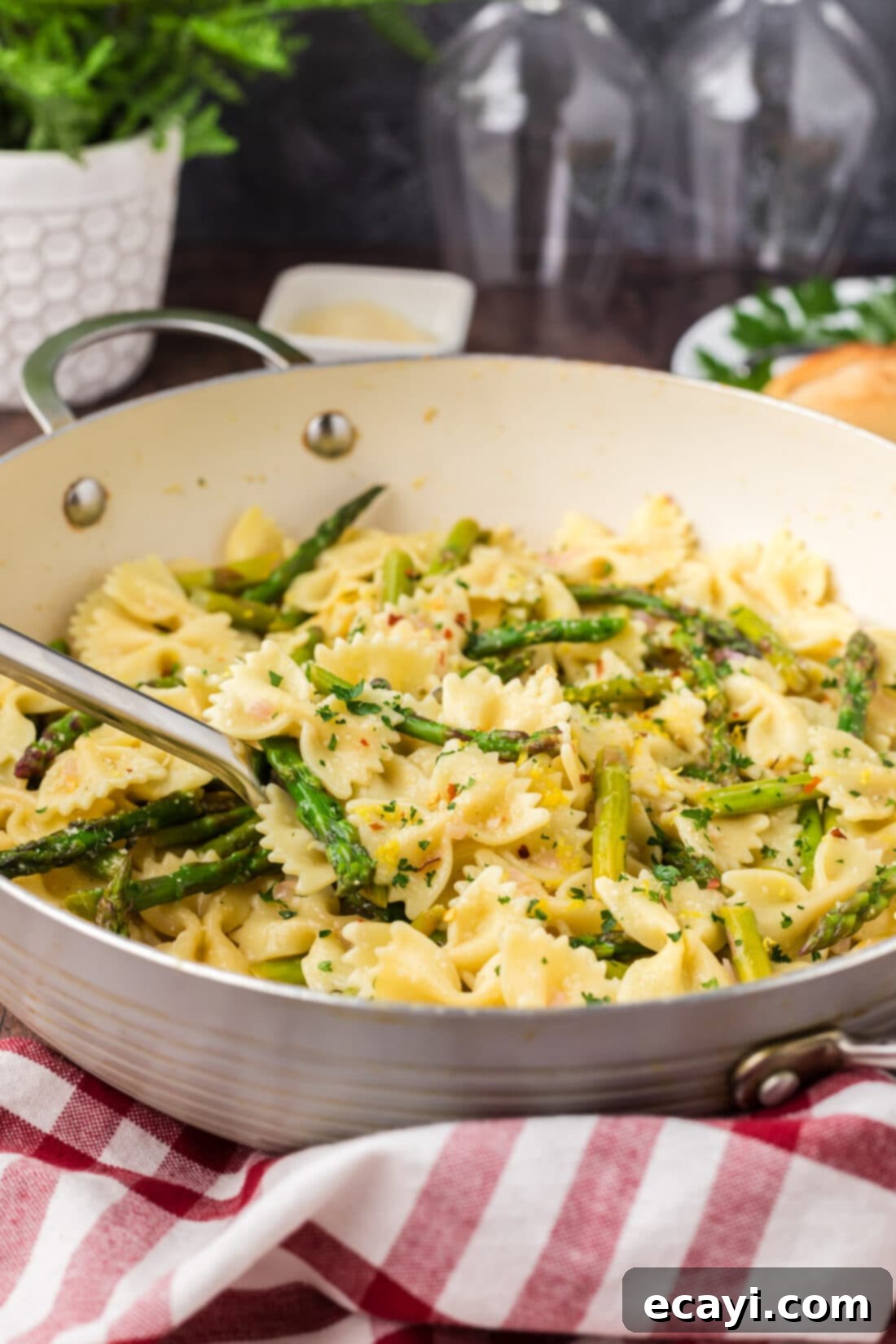
Delightful Serving Suggestions for Asparagus Pasta
This lemon garlic butter asparagus pasta is a truly satisfying meal on its own, but a few thoughtful additions can elevate your dining experience. Serve it warm, garnished generously with your preferred optional toppings: extra fresh lemon zest for an added aromatic lift, a sprinkle of red pepper flakes for a gentle, warming kick, and freshly grated Parmesan cheese for a delightful savory finish. This trio of garnishes isn’t just for looks; they truly enhance the overall flavor profile.
To make it a complete and hearty meal, pair this vibrant pasta dish with some crusty bread or warm garlic bread on the side – perfect for soaking up every last drop of that delicious buttery sauce. A simple, fresh dinner salad with a light vinaigrette would also be an excellent accompaniment, providing a refreshing contrast to the richness of the pasta. For those looking to add more protein, consider serving it with grilled chicken, pan-seared shrimp, or even some thinly sliced, lightly sautéed mushrooms for an earthy touch. Enjoy every flavorful bite!
Explore More Irresistible Pasta Recipes
If you loved this asparagus pasta, you’re in for a treat! We have a treasure trove of delightful pasta recipes that are sure to become family favorites. Dive into these other popular options:
- Pasta Primavera – A garden-fresh pasta dish bursting with seasonal vegetables.
- Mushroom Ravioli – Rich, earthy mushroom-filled pasta for a comforting meal.
- Buffalo Chicken Casserole – A hearty and spicy baked pasta dish perfect for game day or a cozy night.
- Chicken and Shrimp Carbonara – A luxurious and creamy carbonara with added protein.
- Spinach Fettuccine – A vibrant and flavorful pasta that’s both healthy and delicious.
- Broccoli Pasta – A simple yet incredibly tasty pasta dish showcasing the goodness of broccoli.
I absolutely adore sharing my passion for baking and cooking, along with all my kitchen experiences, with each and every one of you! Keeping up with new recipes daily can be a challenge, which is why I offer a convenient newsletter every time a new recipe is published. Simply subscribe today and start receiving your free daily recipes straight to your inbox, ensuring you never miss a delicious meal!
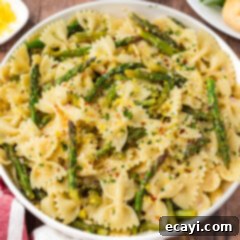
Lemon Garlic Butter Asparagus Pasta
IMPORTANT – There are often Frequently Asked Questions within the blog post that you may find helpful. Simply scroll back up to read them!
Print It
Pin It
Rate It
Save ItSaved!
Ingredients
- ½ pound Farfalle bowtie pasta, cooked al dente (about 8 ounces or 1/2 box)
- 1 bunch fresh asparagus spears
- 5 Tablespoons unsalted butter
- 1 ½ Tablespoons minced fresh garlic
- 2 Tablespoons minced shallots
- 1 cup dry white wine (e.g., Pinot Grigio, Sauvignon Blanc, or substitute with chicken/vegetable broth)
- 1 Tablespoon fresh lemon zest divided
- garlic salt to taste
- 1 Tablespoon cornstarch
- ½ cup cold water
- 2 Tablespoons fresh lemon juice
Optional Garnish
- fresh lemon zest
- red pepper flakes
- grated Parmesan cheese
Equipment You’ll Need
-
Large deep-sided skillet
-
Large saucepan
-
Colander
Before You Begin
- We used elegant bowtie (Farfalle) pasta, but you can confidently use any type of pasta you like. Great options include penne, mostaccioli, delicate angel hair, or classic spaghetti noodles, depending on your preference.
- Using a dry white wine in this recipe significantly enhances the richness and depth of flavor in the sauce. However, if you prefer an alcohol-free version, or simply don’t have wine on hand, an equal amount of good quality chicken or vegetable broth can be used in its place for a delicious result.
- For the brightest and most vibrant flavor, fresh is always best when it comes to lemon juice and zest in this recipe. We strongly recommend skipping pre-bottled lemon juice, as it often lacks the fresh, tangy punch and aromatic qualities that a freshly squeezed lemon provides. Plus, you’ll need that fresh lemon to incorporate its fragrant zest!
Instructions
-
Carefully trim the woody ends off the asparagus spears, then cut the tender spears in half to create bite-sized pieces. Set them aside.
-
Cook your chosen pasta (e.g., Farfalle) according to package directions until it is perfectly al dente. Drain the pasta immediately under cold water to stop the cooking process and prevent it from becoming mushy.
TIP: To keep the pasta from drying out or sticking together while you prepare the sauce, you can either leave it submerged in clean cold water or toss it lightly with a drizzle of olive oil.
-
In a large, deep-sided skillet, melt the unsalted butter over medium-high heat until just foaming.
-
Add the minced garlic and shallots to the skillet and cook for 1-2 minutes, stirring frequently, until they are fragrant and softened. Be careful not to burn them.
-
Pour in the dry white wine (or broth) and half of the fresh lemon zest. Stir well to combine and deglaze the pan.
-
Bring the sauce to a gentle boil, then add the prepared asparagus. Toss to coat the asparagus evenly and season to taste with garlic salt. Cook for 3-5 minutes, or until the asparagus is tender-crisp.
-
While the sauce and asparagus continue to cook, prepare a slurry by whisking together the cornstarch and cold water until smooth. Add this slurry to the skillet, stirring continuously, and continue cooking until the sauce begins to thicken to your desired consistency (about 1-2 minutes).
-
Add the drained, cooked pasta to the skillet with the sauce and asparagus. Toss everything together thoroughly until the pasta is beautifully coated.
-
Finally, stir in the fresh lemon juice, add more garlic salt if needed (taste and adjust!), and sprinkle in the remaining lemon zest. Toss one last time to evenly distribute the flavors and heat the dish through. Serve warm and enjoy!
Expert Tips & FAQs
- Store any leftovers in an airtight container in the refrigerator for up to 4 days. When reheating, use either a microwave or a skillet over medium-low heat until warmed through. Optionally, add a splash of water or broth when reheating to remoisten the pasta and sauce.
- Amanda’s personal tip: I highly recommend taking advantage of the optional garnishes! Surprisingly, the red pepper flakes add just a touch of warmth rather than intense heat (at least for my palate!), and the combination of lemon zest, red pepper flakes, and grated Parmesan truly makes the flavors of this dish sing. It’s a simple step that adds so much depth!
- Don’t overcook the asparagus! Aim for that “tender-crisp” texture where it’s bright green and cooked but still has a slight bite. Mushy asparagus can detract from the dish.
- Taste and adjust seasoning: Always taste your sauce before combining with the pasta and again at the very end. Different brands of garlic salt and personal preferences mean you might want a little more or less.
Nutrition Information
The recipes on this blog are tested with a conventional gas oven and gas stovetop. It’s important to note that some ovens, especially as they age, can cook and bake inconsistently. Using an inexpensive oven thermometer can assure you that your oven is truly heating to the proper temperature. If you use a toaster oven or countertop oven, please keep in mind that they may not distribute heat the same as a conventional full sized oven and you may need to adjust your cooking/baking times. In the case of recipes made with a pressure cooker, air fryer, slow cooker, or other appliance, a link to the appliances we use is listed within each respective recipe. For baking recipes where measurements are given by weight, please note that results may not be the same if cups are used instead, and we can’t guarantee success with that method.
